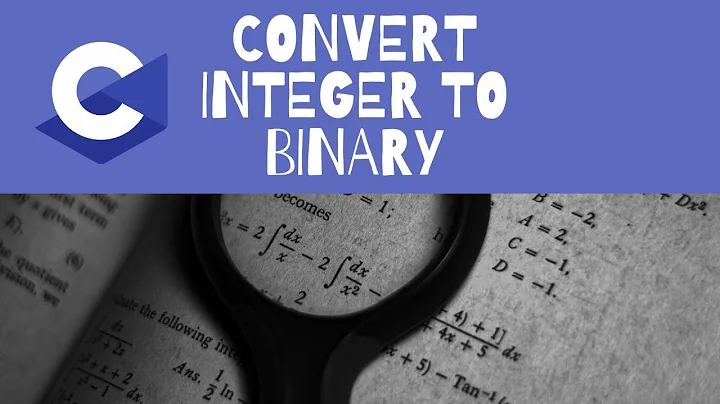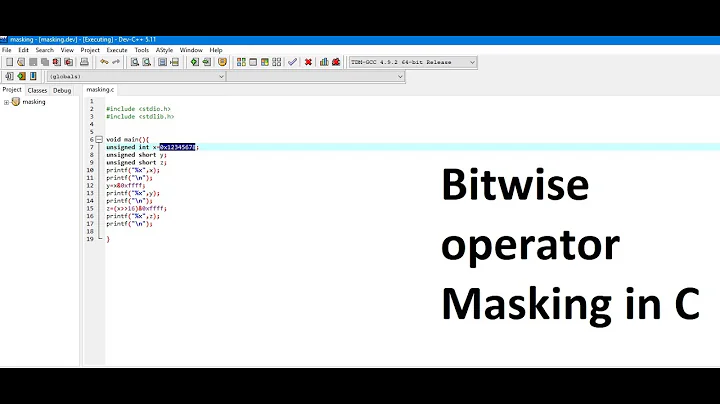convert integer to 32-bit binary in c
14,923
You compute digits starting from the right, which is why your output shows the right-most digit first. Here is a way that starts from the left, using a bitmask, and does not convert your value to unsigned which may change the bits:
#include <stdio.h>
#include <limits.h>
int main()
{
long number;
if ( 1 != scanf("%ld", &number) )
return 1;
// sign bit (cannot use 1L left-shift as that causes UB)
putchar( '0' + (number < 0) );
// value bits
for (long bit = 1L << (CHAR_BIT * sizeof number - 2); bit; bit >>= 1)
putchar( '0' + !!(number & bit) );
putchar('\n');
}
Related videos on Youtube
Author by
naomi88
Updated on September 14, 2022Comments
-
naomi88 over 1 year
I'm writing a program to convert an integer to 32-bit binary. The problem is with the output - it comes backwards.
#include <stdio.h> int main() { long number, binary, num2; printf("Enter an integer: "); scanf("%ld", &number); for (num2 = (number * 2) / 2; num2 > 0; num2 /= 2) { binary = num2 % 2; printf("%ld", binary); } putchar('\n'); return 0; }So if I put '6' it shows as 011 and it has to be 110
Also, how do I output the rest of '0's? So that the whole output in this case would be:
00000000 00000000 00000000 00000110-
 Mitch Wheat about 9 yearsAlso, I typed your question title into a search engine, and unsurprisingly there were many hits!
Mitch Wheat about 9 yearsAlso, I typed your question title into a search engine, and unsurprisingly there were many hits!
-
-
M.M about 9 yearsYou do avoid UB; however
(long)((unsigned long)(number) <<= 1)is implementation-defined which may raise a signal. -
 Weather Vane about 9 years@MattMcNabb my first solution was to assign the
Weather Vane about 9 years@MattMcNabb my first solution was to assign thelongto, and work withunsigned longthroughout, but the explanation was harder to phrase. -
 Weather Vane about 9 years@MattMcNabb ah, just spotted the incorrect
Weather Vane about 9 years@MattMcNabb ah, just spotted the incorrect<<=and edited it out, thank you. -
M.M about 9 yearsHmm we both had the same blind spot, I mean that the
<<version causes implementation-defined behaviour which may raise a signal. (The<<=version was ill-formed). I suppose this algorithm just has to rely on the implementation being "sensible" with its decision there. -
corecase about 7 yearsNice! There's just a small problem, this will print the value in reverse bit order. You might want to switch it up to tail recursion to print in the same bit order as the original value... :)
-
 R Sahu about 7 years@corecase, it prints the high order bits first. Does that not make more sense?
R Sahu about 7 years@corecase, it prints the high order bits first. Does that not make more sense? -
corecase about 7 yearsAssuming a typical host machine, the bit order is usually little endian, so the most significant bits tend to be the left-most bits. I would personally prefer to print out the bits in the same order that they are actually represented on my machine, so this would be in reverse of that order... It's kind of a preference thing and it also depends on the endianness of the machine you're running the code on, but based on the context of this question little endian seems like a more reasonable assumption. It is a pretty minor detail though!
-
 chqrlie over 4 yearsYou should use
chqrlie over 4 yearsYou should use'0'instead of hard coding the ASCII value48. Furthermore you should avoid the non portable gcc extension[0 ... 31]. Finally,binary[31 - i] = number % 2does not produce a digit value, you must add'0'.






